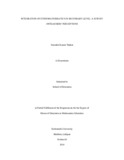
Please use this identifier to cite or link to this item:
https://hdl.handle.net/20.500.14301/361| Title: | Integration of Ethnomathematics in Secondary Level: A Survey on Teachers’ Perceptions |
| Authors: | Thakur, Surendra Kumar |
| Citation: | Thakur, S.K.(2019). Integration of ethnomathematics in secondary level: a survey on teachers’ perceptions |
| Issue Date: | Oct-2019 |
| Publisher: | Kathmandu University School of Education |
| School: | SOED |
| Department: | DOSE |
| Level: | Masters |
| Program: | Master of Education in Mathematics Education |
| Abstract: | The issue of ethnomathematics in academic research has gained its popularity worldwide. Moreover, the results of different research studies related to this area show that it is fruitful tool for mathematics teachers and educators for creating rich conceptual environment for students in learning mathematics. But a question arises here, are teachers aware of this issue? If yes, what are their perceptions on the integration of ethnomathematics?The main purpose of this study was to examine teachers’ perceptions on the integration of ethnomathematics and subsequently teacher perceptions on the integration of ethnomathematics through sources (curriculum, textbook, classroom process and teacher learning) in secondary level. It also examined the relationships among curriculum, textbook, classroom process and teacher learning. Furthermore, this study was to examine significant difference among groups of independent variables regarding teachers’ perceptions on the integration of ethnomathematics in secondary level. This study employed a quantitative cross-sectional survey method that uses self administered questionnaire to collect data from a sample with a target population of all mathematics teachers in all secondary level schools in Lalitpur district out of which 80 mathematics teachers in 42 secondary schools were sampled. The pilot test was conducted to ii test internal consistency of self-administered questionnaire. It revealed strong internal consistency (i.e. 0.93). Descriptive and inferential statistics (parametric and non-parametric test) were used to test the hypothesis of the study. The findings show that teachers’ perceptions on the integration of ethnomathematics were at a moderate level (M = 3.37) and the same result also revealed on four sources of the integration of ethnomathematics namely; curriculum (M = 3.14), textbook (M = 3.23), classroom process (M = 3.60) and teacher learning (M = 3.52). Similarly, the study shows strong and positive relationship among the sources of integration except textbook and teacher learning (r = 0.46). Mann Whitney U test revealed that there was no significant difference between groups of gender, employment status regarding working time and teaching background. The same results also revealed independent sample t-test between groups of family occupation, academic qualification, employment status regarding job placement and schooling background. One-way ANOVA results show that there was no significant difference among the groups of teachers based on their teaching experience, training attendance and graduated faculty. But the results show that there was significant difference among the groups of teachers based on their age and post-hoc comparisons using the Tukey HSD test indicated that the mean score for “ 40 above” group (M = 2.96, SD = 0.72) was significantly different from “20-30” group (M = 3.52, SD = 0.65) and “30-40” group (M = 3.48, SD = 0.53). Therefore, based on the findings of this study, it can be concluded that the relationship among sources are strong and positive, however, the relationship between textbook and teacher learning is weak in comparison with others. Moreover, it can also be concluded that teachers’ perceptions show positive relation regarding integration of ethnomathematics in secondary level. In the same way, the results also reveal that the integration of ethnomathematics takes place through the following sources such as curriculum, textbook, iii classroom process and teacher learning. In terms of demographic independent variables, each group of each variable have positive perception on the integration of ethnomathematics in secondary level. Moreover, the study explored that there is significant difference about teachers’ perceptions on the integration of ethnomathematics. Therefore, age group has a great impact on integration of ethnomathematics among all variables used in this study. Limitations of the study included the use of a convenience sampling, minor statistical assumptions violations, and questionnaire developed by the researcher for this research. In line with the findings of the study, the educational implications of the findings are highlighted in order to include cultural mathematical practices in school and the recommendations are equally proffered in favour of teachers to bring out students’ indigenous mathematical practices. |
| URI: | https://hdl.handle.net/20.500.14301/361 |
| Appears in Collections: | Dissertation |
Files in This Item:
| File | Description | Size | Format | |
|---|---|---|---|---|
| Surendra Thakur_MEd Thesis [Defense].pdf | 1.64 MB | Adobe PDF |  View/Open |
Items in DSpace are protected by copyright, with all rights reserved, unless otherwise indicated.